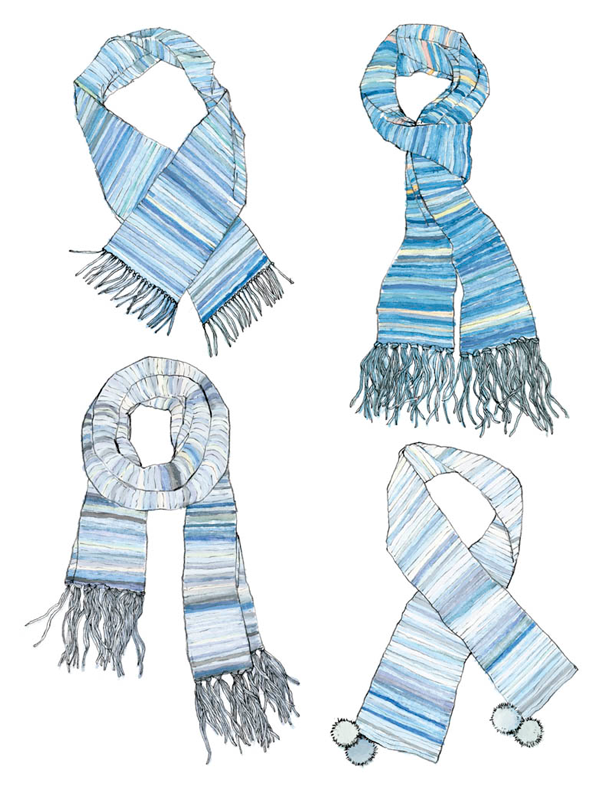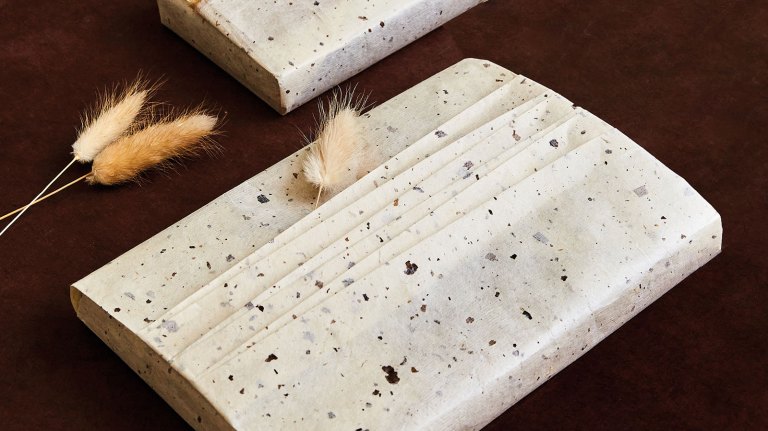Craft Project: Knit the Sky Scarf
A sky scarf is a wearable weather report and a record of a season, or a whole year, with a stripe knitted daily from yarn that matches the color of that day’s sky.
Lea Redmond’s inventive Knit the Sky scarf is a fun and satisfying way to combine crafting with mindful nature observation. Using the basic knit stitch, a pair of needles of any size, and a range of sky-colored yarns (though the project is written with laceweight yarn in mind, any combination of weights and types will do), you can track the changing weather, day by day.
Deborah Balmuth, Publisher

When was the last time you lay on the grass and watched the clouds drift by? Can you recall whether the sky was a brilliant blue or a hazy shade of gray yesterday? What about the day before? And the one before that? Did you take the time to notice? It’s surprisingly easy to forget to look up and appreciate the colorful show that swirls above our heads at every moment. This project asks you to keep an eye on the weather and to track its comings and goings more closely than usual.
As your daily observations meet the clicking of your needles, nature’s patterns — both predictable and erratic — will emerge as the days pile up. Just like the weather, your scarf design will largely be out of your control. You are likely to be surprised by delightful sequences of alternating colors that you never would have devised on your own. Winter’s whites and grays might tire you. But as you heed nature’s ways, you might also learn something about the beauty of waiting. Is a bright blue sky lovelier if you’ve knit a month of gray stripes in anticipation? Is a gray stripe more meaningful if you remember getting caught in a sudden storm with a friend and no umbrella?
With each sunset, the colors of an unrepeatable day fade into the night. Unlike knitting, we can’t unravel a day and relive it. But as the days slip through our fingers, so does our yarn. At the end of a year, you will have a scarf that the clouds have drifted through. Bind off, keep warm, and let your beautiful garment remind you to keep looking up.
Prepare Your Palette
First, gather balls of laceweight yarn that correspond to the various colors of the daytime sky: bright blue, light blue, white, light gray, and dark gray. Using laceweight yarns means you can use the strands doubled so that you have more color options for illustrating the sky. Using US 3 needles, you’ll get a gauge of about 7 stitches to an inch. For example, on a partly cloudy day you might select white and light blue. For a thunderstorm, you might combine light gray and dark gray. And for a pure bright blue sky, you might choose to knit the stripe with two bright blue strands. Make two separate balls of some colors so you’ll have the option for the latter. I’ve found that it’s usually sufficient to split only the two blues (the bright and the light blues) in half. Virtually all weather conditions can be represented by creative pairings of the resulting seven balls of yarn.
Check the Weather
Begin your scarf by choosing the two-strand color combination that best represents the weather on the first day of your project. Treating these two strands as one, cast on 40 stitches. Then, day after day, observe the sky, select the two colors that express its essence best, and add a stripe to your scarf by working 2 rows in garter stitch with those yarns. Continue for a year. Bind off and weave in loose ends.
At What Hour?
You might want to observe the sky at the same time each day. Or you might want to wait until each evening and reflect on the essence of that day’s weather as a whole. For example, even if a bright blue sky prevailed for most of the day, you might still choose gray yarns to represent the booming thunderstorm that suddenly swept through town in the afternoon.
If You Forget a Day . . .
Ask a friend or a neighbor if they can remember what the sky was like that day.
Check your local weather records.
Choose an entirely new color (like red or green) to represent the rare day when you forget to notice the sky.
Text excerpted and adapted from Knit the Sky © Lea Redmon.











